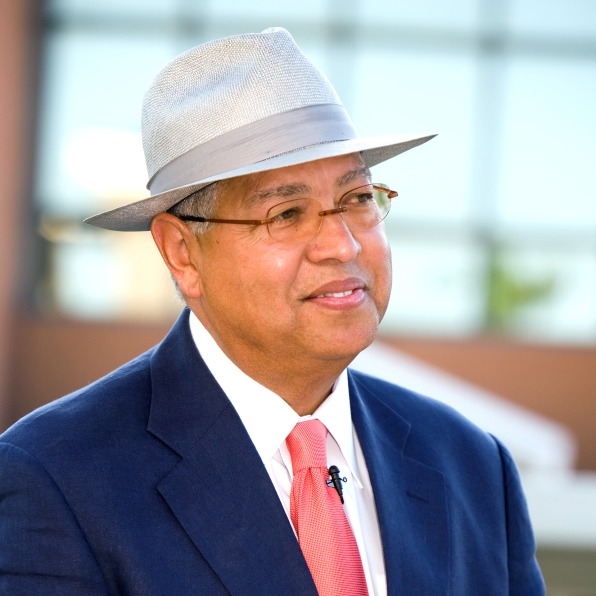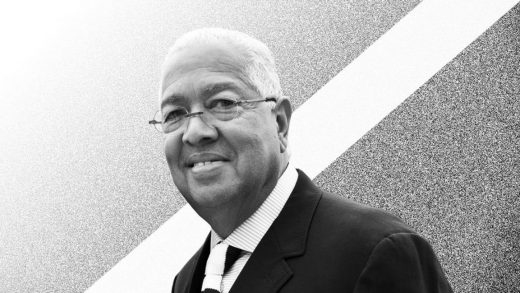A pioneer of corporate diversity remains unimpressed
At 77 years old, Bernard W. Kinsey doesn’t mince words. “The thing that concerns me today is that we continue to try and be citizens of a country that clearly does not see our citizenship at the same level it sees white citizenship,” he says.
These days he spends his time tending to the Kinsey African American Art and History Collection, one of the world’s largest private troves of African American art and historical artifacts, and talking to companies about best practices for creating and maintaining diverse and equitable workforces and cultures.
Kinsey is no stranger to the struggle to the civil rights and inclusivity struggle. In 1963, he was president of the Young Democrats at Florida A&M University, and in that role he helped students arrested during protests on campus. (His future wife, Shirley, was one of those arrested. They have been married for more than 50 years, and their son, Khalil, is general manager and chief curator of the Kinsey Collection.)
Later, he would help lead a major effort to make Xerox Corp. a fairer workplace. Those early programs, which became the subject of a Harvard Business School case study and a PBS NewsHour special report, were intended to be the start of widespread diversity and inclusion in business. Instead, Kinsey finds too many companies have made scant progress, in part because mainstream society tends to ignore the contributions of the Black community while also dismissing inequities.
Kinsey spoke to Fast Company earlier this year about his experiences as a diversity pioneer, the inclusivity principles he developed based on his experiences at Xerox and elsewhere, and the fundamental issues CEOs must address if they want to build truly inclusive workplaces. The following has been edited for length and clarity:

[Photo: courtesy of the Kinsey Family]
In 1971, Xerox, because of affirmative action, wanted to hire Black people. So they hired a Black recruiter. He comes to me. At the time I have a job with Humble Oil Company, with $75 million worth of responsibility. A big job. I’m now supposed to be going from there to a branch manager job. Twelve interviews later, I get the job, and it only has 12 direct reports, and I’m reporting to the person whose job I thought was interviewing for. Now, I have an MBA, a B.S. in math, and five years worth of experience when I got into this job.
If you come into an organization underemployed, you’re never going to catch up.
Luckily, Xerox was growing at a pace where they had to recognize talent. And within nine months I was promoted to the job I should have had.
I’m very proud of what the Black employees at Xerox did. In 1991, Harvard Business School taught [a case study] on the work that we’d done at Xerox to change a culture. When I started in 1971, we had a little over a thousand African Americans. When I left, we had 14,000. We had 26 Black Vice Presidents in 1991. A black person was [in charge of] strategic planning for Xerox. We had a black person that ran the whole country. (Editor’s note: In 2009, when Xerox named Ursula Burns CEO, she became the first Black woman to run a Fortune 500 company.) So every aspect of Xerox had been integrated because of the work of the Xerox employees [starting] in 1971.
We got the CEO of Xerox to understand [that] if Black people are treated fairly in Xerox, those same programs and policies will solve the issues for every [underrepresented group] in the organization.
I get a little teary thinking about some of the guys and ladies who are no longer with us now. Because we worked so hard to build an organization inside of an organization [the National Black Employee Caucus, the first-ever employee resource group] to help that organization be better. And we accomplished that, even though we were [top performers] literally fighting for the same jobs. We had one simple principle we followed: We said you could never talk about yourself in a [caucus] meeting with senior management. Nobody in that group could ever have any conversation with leadership about their own career development. We had a saying: Leave the door open and keep the ladder down.
Xerox would just promote people and you didn’t even know a job was available until somebody else got it. We created a management resource program, and in doing so, we began to select, identify, train, and develop candidates two or three levels down.
By 1980, I’m a vice president at Xerox, [which was then] a Fortune 20 company, and I find out, quite by accident, that my stock options aren’t the same as my peers. So when I bring this back to Xerox, they said, you know, that’s just a mistake. Let’s make up for this. But it still happens over and over and over again.
I want Black people to understand that they [alone] cannot fix this issue. White people are going to have to do some work here. If you’re a CEO, you have to do some extraordinary work to really understand what’s going on in your organization. Because it is so subtle—and maybe in some cases, not so subtle.
Recently I did a Zoom call with about 270 people [from] a huge private corporation. They called me. And the first thing they said was, “We’re 50% diverse.” And I said, “How many Black folks do you have? And they said, “We’ll get back to you,” because they don’t want to talk about it. I said to the CEO, “If you want to deal with Bernard Kinsey, you have to deal with this issue.” To his credit, he came back and said he got it. I still don’t know how many Black people they’ve got, but they were embarrassed, even though they were bragging about being 50% diverse.
If you don’t look at it in categories, you’re just going to miss people. If 20 to 30% of your population is not being utilized, [it isn’t] good for business.
It’s incumbent on the CEO to [ensure the company] looks like the community you serve. When I worked in Oakland, which had a 43% Black population, we said, a big portion of [our workforce] should be Black. And we ended up with 33% Black [employees] in Oakland.
The big issue in America is not so much affirmative action, diversity, or activism. The big issue is that white America has never understood what Black America did in this country. The Kinsey Collection’s principal objective is to put the African American story in the narrative, because the narrative that was created by whites was that we were an inferior people. And we did not have agency in this country. And that’s what we’re facing every day in 2020, that our citizenship is not legitimate as it relates to the rest of society. And unfortunately, that can’t come about until the story of accomplishment and achievement of African Americans in this country is fully understood by whites and other minorities.
Our son, Khalil, said it best. He said, “Dad, if you respect me and I don’t respect you, how could we ever have an eye-level of conversation?” That’s it. And America does not respect Black people unless you bring all your credentials, and even then you have to keep proving these things over and over and over again. The Kinsey Collection begins in 1595, not 1619 [the year enslaved Africans arrived in Virginia], which is not the beginning of Black people in America. We have a marriage certificate from 1598, [showing Black couples] getting married in St. Augustine, [Florida]. (The collection also includes a certificate of the earliest-known Black baptism, also in St. Augustine, in 1595.) Nobody knows about these stories because they don’t fit the narrative that America has of Black people.

[Photo: courtesy of The Kinsey Collection]
I would not have believed that we would be where we are in the conversation in America, and that’s because of Black Lives Matter. It reminds me so much of the ’60s and the Civil Rights Movement. I think this is as consequential as the Civil Rights Movement, in a different way, because now what we’re trying to do is to get at this subconscious racism that’s right below the surface that affects every aspect of American life.
This country went from a backwater to the No. 1 country in the world in 1872, because of slavery and Black people still have never gotten even a modicum of support. The grievance we have is a grievance that’s long standing. And what we are just trying to say is, we need to be able to have some degree of access to this American dream. People will say, “Well, you did well.” [They don’t see] the extraordinary work that Shirley and I put in, the sacrifices to be able to get through the system. Even for us it gets difficult. But we’ve built up the right kind of values to be able to deal with anything that comes to us.
Fast Company , Read Full Story
(15)



